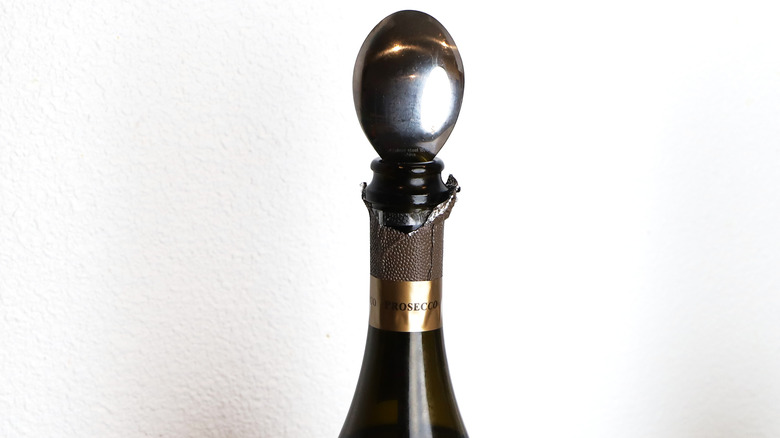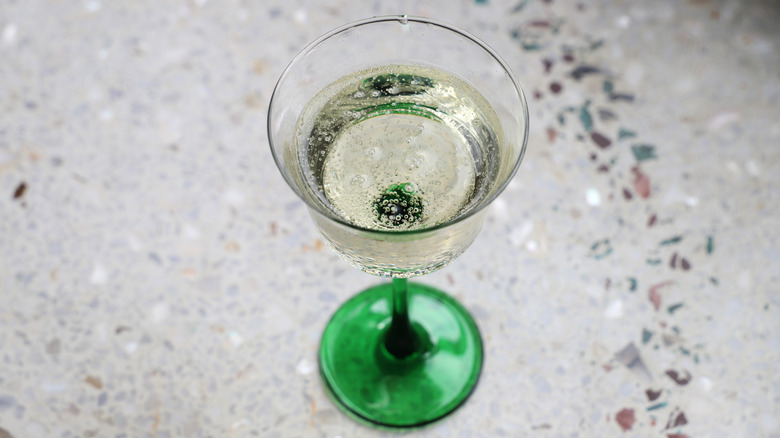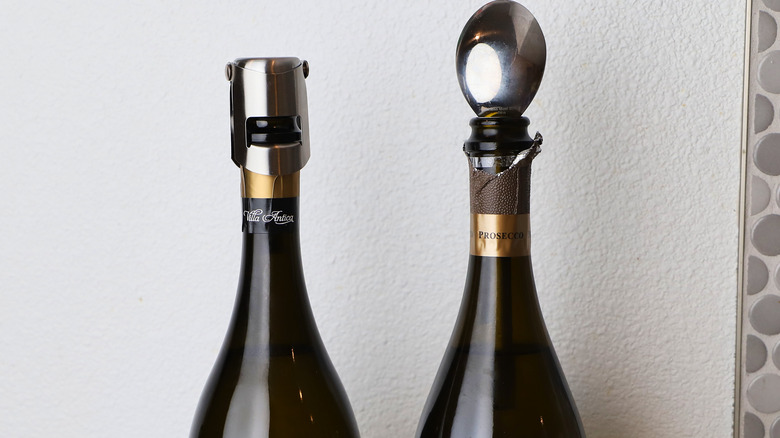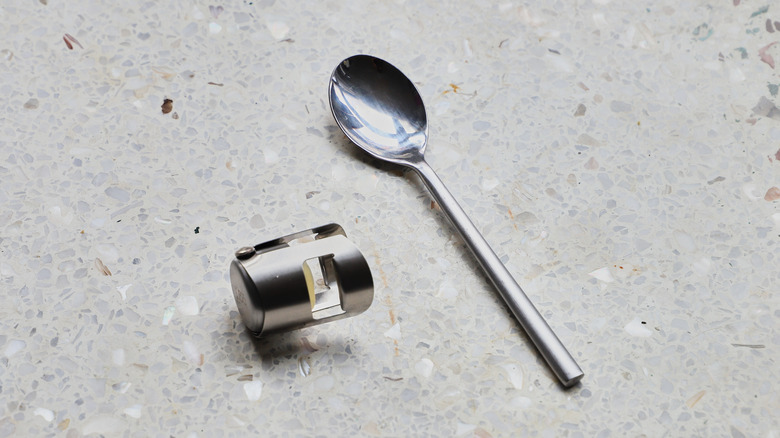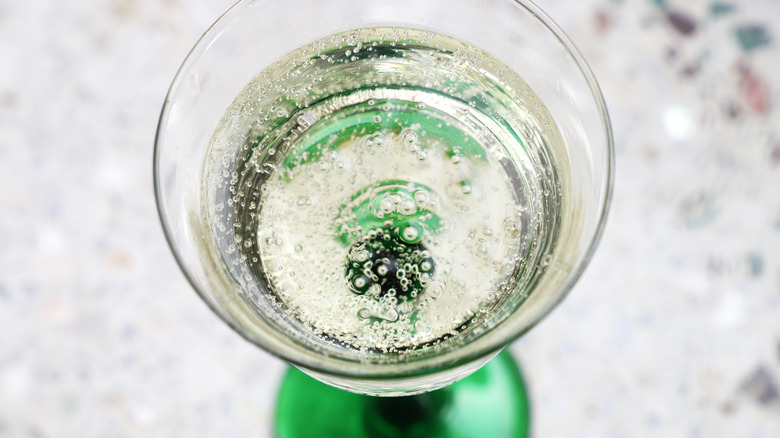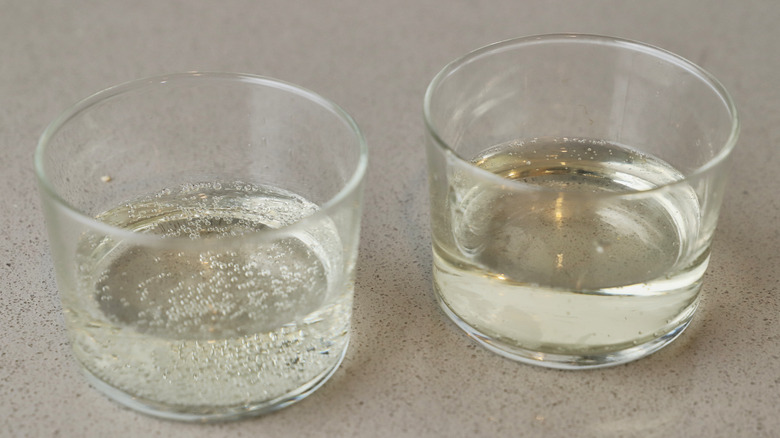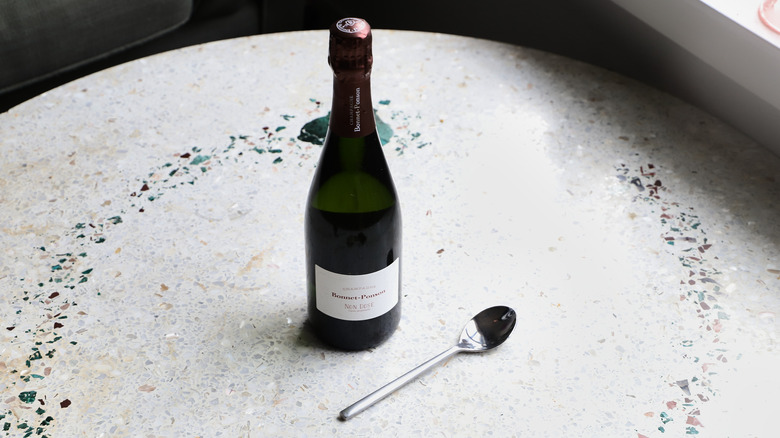Does Putting A Spoon In The Bottle Keep Champagne Carbonated?
For every kitchen-related predicament, there's no doubt an internet hack that claims to sidestep an everyday dilemma. One of this season's viral solutions for a minor at-home quandary claims to solve the age-old impasse of how to store an open bottle of sparkling wine.
As a note, the internet largely refers to this hack as the "spoon in champagne trick" or "how to keep champagne bubbly." But we're sticklers about champagne classification and will (correctly) only refer to the (perfectly delicious) bottles of bubbly wine not from the Champagne region (like Prosecco or Cava) as sparkling wine.
Nevertheless, the general claim insists that placing a silver spoon inside the neck of an open bottle of sparkling wine will preserve the wine's bubbles for up to a week inside the caverns of your fridge. This hack is curious because the spoon's surface nowhere near covers the mouth of a bottle of wine and leaves substantial gaps on either side of the spoon's head to allow for airflow, thus releasing CO2 (and its playful pleasurable bubbles) along with it.
Behind the bubbles
Though there are a small handful of methods to produce sparkling wine (champenoise method, in tank, transfer, carbonation, and asti), once a wine is made bubbly, the effervescence arrives in the form of carbonated dioxide gas in little bubbles of varying degrees of size and intensity.
The bubbles, along with pleasurably tickling the nose and frolicking on the tongue, also help clean the palette and prepare their drinker for the next bite of food. This is why champagne (and other sparkling wines) are the most versatile alongside food, especially when it comes to fatty items like fried chicken or cheese.
So retaining a carbonated wine sparkle remains paramount to keeping the bottle alive to be drunk on day two, three, or even four; however, exposure to air allows the carbon dioxide to escape the bottle and the wine's lifetime to shorten. Though we rarely pop a bottle of bubbles we don't plan on polishing off that same evening, most bottles (with the exception of some pét-nat wines) should survive through the night with a decent plug, stopper, or possibly spoon.
Why the spoon trick might work
Though making an online resurgence, the spoon trick has been floating around wine circles since the '90s. Put to the test by Stanford in 1994, the academic study revealed a positive outcome for the lifestyle hack, but the nitty-gritty of the science behind why exactly sticking a silver spoon inside an opened bottle would preserve it is still foggy.
Andy Young, the winemaker behind Oregon's lauded St. Reginald Parish wines, believes the spoon trick could be more dependent on the cold fridge than the spoon itself, stating that "the wine's trapped gas stays put easier in a cold environment. That is totally true and one reason I keep my cellar so cold post-fermentation." The importance of the silver spoon remains obscure, and Young would rather "just roll up a bit of paper towel into a cone and place it into the neck (if he doesn't have a proper stopper around), just to keep some gas in the bottle."
Putting the spoon to the test
To put this theory to rest once and for all, we tested the spoon method alongside an industry-approved sparkling wine stopper. We tasted our open bottles of wine over four days, talking to experts and researching the validity of this household hack. Tyler Damato, a Portland-area wine rep, reluctantly leans on the spoon method, stating, "we all know that once you buy one of those fancy little champagne stoppers, you use it once, and it magically disappears forever." Therefore, he told us that leaning on a household spoon is handy, as "it allows you to savor your pricier bubbles as opposed to having to chug them."
We popped open two (reasonably priced) sparkling wines on the same day with similar levels of effervescence, plugged one with a metal wine stopper popular in many restaurants, and slipped a long, silver spoon into the second bottle. We placed both bottles on the same level of our refrigerator and tasted each throughout a four-day period to test the livelihood of the wine's bubbles.
Days 1-2
On the first day after opening, we stuck the bottles in our fridge with only the neck (about two ounces) missing from the opened bottle, giving the air from the refrigerator a smaller chance to reach the surface of the wine. The wine secured with the metal stopper audibly popped once reopened and poured with the same level of carbonation as the day prior. The bottle with the spoon plunged into the neck also remained mostly unchanged but had slightly deflated from the previous day.
On day two, however, the disparities between the bottles started to show. The first wine, protected by a metal stopper, still gave out a little burst once unlatched and still held on to about 70% of the original bubbles. In contrast, the bottle endowed with only a spoon began its death rattle and drank closer to a wine with a slight effervescent like a Spanish Txacoli or Vinho Verde than a true sparkling wine. At this point, our wine level had depleted to about half a bottle (approximately two glasses drank and two remaining), leaving a greater surface of the wine exposed to the air inside the bottle.
Days 3-4
By day three, even the bottle crowned with the metal stopper had become much less pronounced as far as bubbles but still built up a visible fizz while poured into a glass or cajoled by stirring. The spoon-stopped wine, on the other hand, had nearly lost all liveliness and could only cough up a sparse amount of visible bubbles that were barely noticeable on the tongue.
As day four rolled around, the bubbles fastened with a traditional stopper still fizzed when first poured but were obviously deflated from their initial charm. The bottle of sparkling wine adorned with only a silver spoon, however, was left exposed to the elements of our refrigerator and officially pronounced dead and was no longer recognizable as a sparkling wine. Stale tasting and entirely still, the spoon-adorned bottle we tested lost its carbonation and tasted off. Originally we intended this trail to last up to a week, but after day four, the spooned bubbles were so flat we dumped the remaining wine down the drain.
Does it work?
After testing the spoon method on a bottle of sparkling wine, we can firmly say that we will never return to the now silly seeming hack. Not only was the bottle of wine empty of bubbles after three days of sitting stagnant in our fridge, but the wine itself was stripped from its original flavor and left vulnerable to oxidation. We'd never leave an open bottle of still wine uncorked inside our fridge (spoon or no spoon), so the notion of abandoning a stopper of any kind, even overnight with a bottle of sparkling wine, should've set off alarm bells immediately. We suspect that the chill of our fridge was the element working in the bubble's favor for that first night, and the spoon was more or less a red herring.
Our dedication and gratitude toward our trusty sparkling wine stopper have doubled since our test. We're more interested in testing other stoppers and wine preservation systems with scientific backing instead of an unproven hack. And if we're ever caught without a sanctioned stopper, we'll be employing Andy Young's paper towel method instead.
